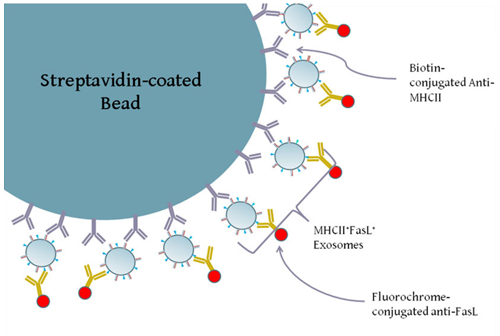Exosome Biotinylation Service
Overview Services Features FAQs
Biotinylation involves the attachment of biotin molecules to specific proteins or molecules within exosomes. Creative Biolabs has developed an advanced biotin labeling platform to assist clients in exosome labeling.
Biotin Labeling
The tiny chemical biotin can bind covalently to other molecules, proteins, and nucleic acids. The quick, targeted process known as "biotinylation" is unlikely to interfere with the normal functioning of proteins or other target molecules. Biotin has a very high affinity, quick on-rate, and great specificity when it comes to non-covalently binding to streptavidin and avidin. The non-covalent interactions are very strong, even more than the affinity between antibodies and antigens, and are resistant to extremes of heat, pH and proteolysis. Thus biotin binding to streptavidin (SAV) and avidin is exploited to detect and/or purify proteins. The conjugation of numerous biotin molecules to a target protein enhances the sensitivity of protein detection by enabling the binding of multiple streptavidin, avidin, or neutravidin protein molecules.
Exosome Biotinylation Service
By biotinylating exosomes, researchers can tag them with biotin molecules, which can then be easily detected or isolated using streptavidin-based techniques. This can be useful for tracking exosomes in biological samples, studying their interactions with cells or tissues, or purifying them for further analysis or therapeutic purposes. Our services cover the steps below.
-
Isolation of Exosomes: Exosomes are isolated from the desired biological sample using ultracentrifugation, density gradient centrifugation, or size exclusion.
-
Biotinylation Reaction: Exosomes are incubated with a biotinylation reagent, such as NHS-biotin, to label surface proteins with biotin molecules.
-
Purification: Biotinylated exosomes are purified using methods such as size exclusion chromatography or ultracentrifugation to remove excess biotinylation reagents and impurities.
-
Quality Control: Thorough quality control procedures are used for the biotinylated exosomes to guarantee integrity, purity, and effective biotinylation.
-
Packaging and Delivery: Biotinylated exosomes are packaged appropriately and delivered to the customer for downstream applications.
Features of Exosome Biotin Labeling at Creative Biolabs
-
High-Efficiency Biotinylation: Our service ensures efficient and specific biotinylation of exosomes, minimizing non-specific labeling.
-
Customizable Options: We offer flexibility in biotinylation protocols to meet specific research needs, including choice of biotinylation reagents and labeling densities.
-
Rigorous Quality Control: Each batch of biotinylated exosomes undergoes comprehensive quality control assessments to guarantee consistency and reliability.
 Fig.1 Diagram of exosome-bead capture experiments.1
Fig.1 Diagram of exosome-bead capture experiments.1
FAQs
Q: What is the advantage of biotinylating exosomes?
A: Biotinylation allows for specific and efficient labeling of exosomes, enabling various downstream applications such as tracking, isolation, and targeting.
Q: How stable are biotinylated exosomes?
A: Biotinylated exosomes are stable under typical storage conditions (-80°C) for several months without significant loss of biotin labeling or integrity. However, repeated freeze-thaw cycles should be avoided to maintain optimal performance.
Q: Can biotinylated exosomes be used for in vivo studies?
A: Yes, biotinylated exosomes can be used for in vivo studies, but additional validation may be required to ensure their safety and efficacy in animal models.
Equipped with state-of-the-art platforms, scientists in Creative Biolabs are more than happy to support you in exosome biotin labeling. Please contact us with your demands.
Reference
-
Klinker, Matthew W., et al. "Human B cell-derived lymphoblastoid cell lines constitutively produce Fas ligand and secrete MHCII+ FasL+ killer exosomes." Frontiers in Immunology 5 (2014): 144. Under Open Access license CC BY 3.0, without modification.
For Research Use Only. Cannot be used by patients.
Related Services:

 Fig.1 Diagram of exosome-bead capture experiments.1
Fig.1 Diagram of exosome-bead capture experiments.1









